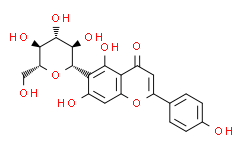| Description: |
Isovitexin is a flavonoid isolated from rice hulls of Oryza sativa, possesses anti-inflammatory and anti-oxidant activities; Isovitexin acts like a JNK1/2 inhibitor and inhibits the activation of NF-κB. |
| In Vivo: |
Isovitexin (50 and 100 mg/kg, i.p.) causes less severe histopathological changes in the lung sections, and reduces inflammatory cell count in LPS-induced mice. Isovitexin (50 and 100 mg/kg, i.p.) protects against LPS-induced inflammation and oxidative stress in LPS-induced ALI mice by decreasing TNF-α and IL-6 production, ROS generation, and MPO and MDA content, increasing SOD and GSH levels and effectively inhibiting the protein expression of iNOS and COX-2[1]. Isovitexin (25, 50, 100 mg/kg) dose-dependently reduces the survival rate of LPS/D-gal induced hepatic injury in mice. Isovitexin also inhibits NF-κB activation and up-regulates Nrf2 and HO-1 induced by LPS/D-gal in mice[2]. |
| In Vitro: |
Isovitexin protects against LPS-induced oxidative damage by suppressing intracellular ROS generation, and also attenuates the effect of H2O2 on cell viability. Isovitexin (0-100 μg/mL) with LPS (2 μg/mL) is not cytotoxic to RAW 264.7 cells, but 200 μg/mL Isovitexin shows significant cytotoxicity. Isovitexin (25, 50 μg/mL) inhibits LPS-induced increases in TNF-α, IL-6, iNOS, and COX-2 levels. Isovitexin (25, 50 μg/mL) also suppresses the IκBα phosphorylation and degradation in RAW 264.7 cells, and such an effect is consistent with that of JNK1/2 inhibitor[1]. |
| Cell Assay: |
Cell viability is determined by an MTT assay. RAW 264.7 cells are plated in 96-well plates (1 × 104 cells/well) and incubated with various concentrations of Isovitexin (final concentration: 0-200 μg/mL) and LPS (2 μg/mL) for 24 h. In addition, the cells are pretreated with IV (25 or 50 μg/mL) for 1 h, followed by the addition of H2O2 (300 μM). After 24 h, MTT (5 mg/mL) is added to the cells, which are then incubated for another 4 h[1]. |
| Animal Administration: |
Mice[1] To create an ALI model, mice are randomLy divided into six groups: control (saline), Isovitexin only (100 mg/kg, dissolved in 0.5% DMSO), LPS only (0.5 mg/kg, dissolved in saline), LPS (0.5 mg/kg) + Isovitexin (50 or 100 mg/kg), and LPS (0.5 mg/kg) + dexamethasone (Dex, 5 mg/kg dissolved in saline). Isovitexin or Dex (5 mg/kg) are administered Isovitexin. After exposure to Isovitexin or Dex for 1 h, the mice are anesthetized with diethyl ether, and LPS is administered intranasally (i.n.) to induce lung injury. After LPS administration for 12 h, the animals are euthanized. Accordingly, bronchoalveolar lavage fluid (BALF) and lung tissue samples are harvested to measure cytokine levels; ROS generation; SOD, GSH, MDA and MPO activity; and COX-2, iNOS, HO-1, and Nrf2 protein expression[1]. |
| References: |
[1]. Lv H, et al. Isovitexin Exerts Anti-Inflammatory and Anti-Oxidant Activities on Lipopolysaccharide-Induced Acute Lung Injury by Inhibiting MAPK and NF-κB and Activating HO-1/Nrf2 Pathways. Int J Biol Sci. 2016 Jan 1;12(1):72-86.
[2]. Hu JJ, et al. Isovitexin alleviates liver injury induced by lipopolysaccharide/d-galactosamine by activating Nrf2 and inhibiting NF-κB activation. Microb Pathog. 2018 Mar 29;119:86-92. |






















